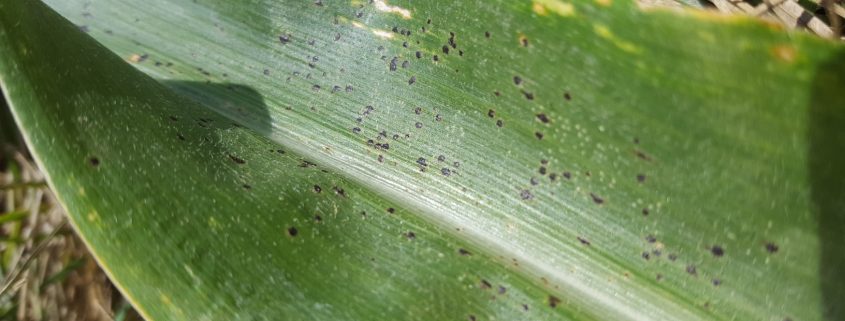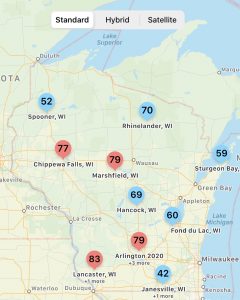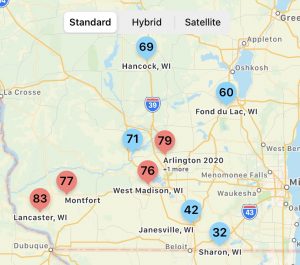Wisconsin Corn Tar Spot Update – July 9, 2020
Damon Smith, Extension Field Crops Pathologist, Department of Plant Pathology, University of Wisconsin-Madison
Roger Schmidt, Nutrient and Pest Management Program, University of Wisconsin-Madison
Tar spot has been detected on corn for the first time during the 2020 season, this week in Michigan and Indiana. In both situations these were fields with a history of the disease. Incidence and severity is very low, suggesting that the recent warm, dryer weather may be keeping tar spot in check at these sites. Figure 1, show the location of these detections.

Figure 1. Corn IpmPIPE tar spot confirmations for U.S. Counties as of July 9, 2020. Grey shading indicates past confirmation in the county. Orange shading indicates a positive confirmation for 2020.
Figure 2 shows the calculated risk from Tarspotter (our smartphone prediction tool for tar spot) for July 9, 2020, for various locations in Wisconsin. Figure 3 shows the risk for locations in southern and south-central Wisconsin. The action threshold for high risk is 75% using the updated Tarspotter model for 2020. As you can see, the present risk is elevated in much of the southern portion of the state, with areas of high risk in the western half of the state. This is due to the fact that the weather continues to be relatively wet and humid for the past 30 days with decent rainfall across this portion of the state, despite relatively warm temperatures. Tar spot is favored by persistent temperatures between 60 and 70 F and high relative humidity averaging above 75% for a 30-day period, accompanied by extended periods of leaf wetness caused by dew, rain, or irrigation events. The newest Tarspotter tool captures all of these aspects and balances these in the calculations of risk in the map above.
We have been scouting fields in the southern portion of the state where there has been a history of tar spot. We have been unable to find any symptoms of tar spot thus far. Fields generally look disease free, which is common this time of year in Wisconsin.
The Recommendation
Even if weather turns more favorable for tar spot, evaluate the likelihood that tar spot might develop early in your field. Remember, if you have no history of the disease, then the likelihood of local inoculum being present is low. Saving the fungicide application for later in the season might be a better option. If you have a history and you know you have a susceptible hybrid coupled with a no-till situation, then the risk is higher and you need to evaluate the economics of doing an application of fungicide in early or mid v-stages. Remember, if you do a V6-V8 application of fungicide, conditions could stay conducive later in the season for tar spot. Those early applications will “burn out” by the time the tasseling period rolls around. So if you do (or did) put a fungicide spray on at V6-V8, you might have to come back at VT-R2 with another application to protect plants during the reproductive phase, should favorable conditions for tar spot persist. Keep an eye on the weather and keep scouting!
More Tar Spot Information







